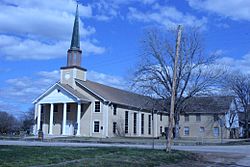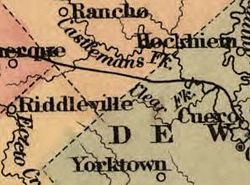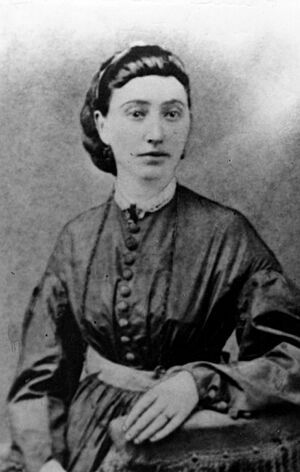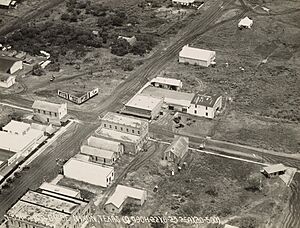Nixon, Texas facts for kids
Quick facts for kids
Nixon, Texas
|
|
|---|---|
|
The Nixon area, shown as "Rancho" and "Clear Fork" around 1873. The 20th-century Baptist church architecture of Nixon is also shown.
|
|
| Country | United States |
| State | Texas |
| Counties | Gonzales, Wilson |
| Settled | 1849 (Rancho) |
| Founded | 1852 (R.T. Nixon Plantation) |
| Incorporated | 1906 (John T. Nixon Tract) |
| Area | |
| • Total | 1.57 sq mi (4.06 km2) |
| • Land | 1.56 sq mi (4.05 km2) |
| • Water | 0.01 sq mi (0.01 km2) |
| Elevation | 387 ft (118 m) |
| Population
(2020)
|
|
| • Total | 2,341 |
| • Density | 1,626.36/sq mi (627.94/km2) |
| Time zone | UTC-6 (Central (CST)) |
| • Summer (DST) | UTC-5 (CDT) |
| ZIP code |
78140
|
| Area code(s) | 830 |
| FIPS code | 48-51588 |
| GNIS feature ID | 2411257 |
Nixon is a city in the U.S. state of Texas. It is located where U.S. Highway 87 meets the borders of Karnes, Gonzales, and Wilson counties. The city is near Clear Fork Creek.
In 2020, the population of Nixon was 2,341 people. Most of Nixon is in Gonzales County. However, many of its main businesses are closer to the Wilson County line. The city covers about 1.6 square miles (4.06 square kilometers) of land. The part of Nixon in Wilson County is considered part of the San Antonio metropolitan area.
Nixon developed from the land owned by the Nixon family in the late 1800s. It started as a large farm called a plantation. Later, it became a rail station and was first known as "Rancho." This name came from the area's cattle industry. Today, Nixon is served by businesses like an oil refinery and a chicken processing plant.
Contents
City Services and Businesses
Holmes Foods
Holmes Foods started in 1925 as an ice plant. It grew into a large facility that processes chickens. By 2010, this plant processed about 700,000 chickens every week. It was one of the biggest poultry processors in the country.
The facility also handles its own wastewater. This water is stored in special ponds and then used to water hay fields for cattle.
RV Parks
Many of the main roads in Nixon have areas set aside for recreational vehicle parks. These parks are managed by the city through a special licensing program.
History of Nixon
The history of Nixon involves the changes and challenges faced by some of its important early settlements.
Old Nixon Settlement
In 1852, Robert T. Nixon started the first settlement called Nixon. This place is now known as the ghost town "Old Nixon." It was a large farm of 14,000 acres between Belmont and Luling. Interestingly, this plantation did not use enslaved people. Its main activities were raising cattle and horses.
By 1899, Old Nixon had a cotton gin, two schools, a church, a blacksmith, and several homes. There were also stores like "Wagner's Store" and "Nixon and Stephens." Robert T. Nixon's brother, John T. Nixon, lived near what is now northern Nixon. The name "Nixon" was later moved from the old town to the new town built on John T. Nixon's land.
Today, the only part of the original Old Nixon settlement that remains is its cemetery.
Rancho-Nixon Settlement
While Old Nixon was being founded, another settlement called Rancho grew. It was located where present-day Nixon begins. Paul Murray opened a country store there in 1849. His store was at a crossroads leading to important towns like San Antonio, Gonzales, and Cuero.
The area was first named "Rancho" because of its ranching culture. Cowboys in Rancho gathered cattle to sell in northern markets. In 1855, a post office was opened. Rancho grew to have businesses, a school, and two churches.
Rancho's population quickly dropped after 1906. This happened when the Galveston, Harrisburg and San Antonio Railroad built its tracks two miles south, bypassing Rancho. Many people and buildings moved to the new railroad town of Nixon. By 1911, the post office closed, and most of Rancho's residents had moved. Rancho is a reminder of many towns that disappeared when railroads changed their routes.
Union-Nixon Settlement
Near the Wilson County part of Nixon, there was a town called Union or "Union Valley." Its postal services were moved to Nixon in 1915. Union was settled before the American Civil War. It once had a population of up to 300 people and several stores. Over time, it became part of the larger Nixon community.
Modern Nixon
Nixon began to develop as a modern town around 1869. This was near the site of its First Baptist Church. The San Antonio Baptist Association helped establish a local church here.
The church's members had a building in Rancho, but they moved it to the Nixon congregation when the city officially became a town in 1907. The Nixon First Baptist Church is seen as an important part of the community's early culture.
Nixon News Newspaper
In the early 1900s, Nixon had its own newspaper called Nixon News. It stopped publishing in September 1921. The editor said it was because of a lack of support from local businesses and the community.
The newspaper's name returned from 1980 to 1986. During this time, it helped organize three yearly city festivals. These festivals celebrated Nixon's poultry products, which were said to be the most in Texas. The Nixon News even won an award for "Community Service" in 1980.
From 2013 to 2017, an online version of "The Nixon News" was published. It shared local news and politics. This online paper is also no longer published.
Traffic Signal Delays
Around 2015, the Texas Department of Transportation faced problems installing new traffic lights at the intersection of U.S. Highway 87 and Texas State Highway 80 in Nixon. The project faced many delays, taking over three and a half years to complete. This was much longer than a normal upgrade.
COVID-19 in Nixon
In late March 2020, the first confirmed case of COVID-19 in Gonzales County was found in Nixon.
Population Information
| Historical population | |||
|---|---|---|---|
| Census | Pop. | %± | |
| 1920 | 1,124 | — | |
| 1930 | 1,037 | −7.7% | |
| 1940 | 1,835 | 77.0% | |
| 1950 | 1,875 | 2.2% | |
| 1960 | 1,751 | −6.6% | |
| 1970 | 1,925 | 9.9% | |
| 1980 | 2,008 | 4.3% | |
| 1990 | 1,995 | −0.6% | |
| 2000 | 2,186 | 9.6% | |
| 2010 | 2,385 | 9.1% | |
| 2020 | 2,341 | −1.8% | |
| U.S. Decennial Census | |||
| Race | Number | Percentage |
|---|---|---|
| White (NH) | 326 | 13.93% |
| Black or African American (NH) | 55 | 2.35% |
| Asian (NH) | 9 | 0.38% |
| Some Other Race (NH) | 6 | 0.26% |
| Mixed/Multi-Racial (NH) | 31 | 1.32% |
| Hispanic or Latino | 1,914 | 81.76% |
| Total | 2,341 |
As of the 2020 United States census, Nixon had 2,341 people living in 764 households. Most of the people living in Nixon are of Hispanic or Latino background.
In 2000, there were 2,186 people in Nixon. About 42% of households had children under 18. The average household had about 3 people. The median age in the city was 31 years old.
The median income for a household in Nixon was $22,104. About 27.5% of the population lived below the poverty line.
Climate and Weather
Nixon has a humid subtropical climate. This means it has hot, humid summers and mild winters. The hottest temperature ever recorded in Nixon was 113°F (45°C) on July 26, 1954. The coldest temperature was 1°F (-17°C) on December 24, 1989.
| Climate data for Nixon, Texas, 1991–2020 normals, extremes 1948–present | |||||||||||||
|---|---|---|---|---|---|---|---|---|---|---|---|---|---|
| Month | Jan | Feb | Mar | Apr | May | Jun | Jul | Aug | Sep | Oct | Nov | Dec | Year |
| Record high °F (°C) | 90 (32) |
95 (35) |
100 (38) |
101 (38) |
103 (39) |
110 (43) |
113 (45) |
109 (43) |
112 (44) |
99 (37) |
92 (33) |
88 (31) |
113 (45) |
| Mean maximum °F (°C) | 79.6 (26.4) |
83.1 (28.4) |
87.1 (30.6) |
90.9 (32.7) |
93.6 (34.2) |
98.4 (36.9) |
100.2 (37.9) |
101.5 (38.6) |
98.8 (37.1) |
93.4 (34.1) |
86.0 (30.0) |
81.1 (27.3) |
103.3 (39.6) |
| Mean daily maximum °F (°C) | 64.8 (18.2) |
68.1 (20.1) |
74.2 (23.4) |
81.0 (27.2) |
87.2 (30.7) |
93.1 (33.9) |
95.3 (35.2) |
97.4 (36.3) |
91.4 (33.0) |
83.8 (28.8) |
73.6 (23.1) |
65.9 (18.8) |
81.3 (27.4) |
| Daily mean °F (°C) | 51.4 (10.8) |
55.3 (12.9) |
61.8 (16.6) |
68.3 (20.2) |
75.8 (24.3) |
81.7 (27.6) |
83.6 (28.7) |
84.5 (29.2) |
78.9 (26.1) |
70.4 (21.3) |
60.6 (15.9) |
53.3 (11.8) |
68.8 (20.5) |
| Mean daily minimum °F (°C) | 38.3 (3.5) |
42.5 (5.8) |
49.3 (9.6) |
55.7 (13.2) |
64.5 (18.1) |
70.2 (21.2) |
72.0 (22.2) |
71.6 (22.0) |
66.5 (19.2) |
57.1 (13.9) |
47.7 (8.7) |
40.8 (4.9) |
56.4 (13.5) |
| Mean minimum °F (°C) | 25.2 (−3.8) |
29.3 (−1.5) |
32.4 (0.2) |
40.3 (4.6) |
51.3 (10.7) |
64.0 (17.8) |
67.8 (19.9) |
67.3 (19.6) |
55.5 (13.1) |
40.4 (4.7) |
31.2 (−0.4) |
26.3 (−3.2) |
23.0 (−5.0) |
| Record low °F (°C) | 3 (−16) |
5 (−15) |
22 (−6) |
29 (−2) |
39 (4) |
54 (12) |
56 (13) |
57 (14) |
43 (6) |
27 (−3) |
21 (−6) |
1 (−17) |
1 (−17) |
| Average precipitation inches (mm) | 2.11 (54) |
2.21 (56) |
2.70 (69) |
3.08 (78) |
4.36 (111) |
3.60 (91) |
2.45 (62) |
3.14 (80) |
2.98 (76) |
3.16 (80) |
2.19 (56) |
2.41 (61) |
34.39 (874) |
| Average snowfall inches (cm) | 0.0 (0.0) |
0.0 (0.0) |
0.0 (0.0) |
0.0 (0.0) |
0.0 (0.0) |
0.0 (0.0) |
0.0 (0.0) |
0.0 (0.0) |
0.0 (0.0) |
0.0 (0.0) |
0.0 (0.0) |
0.1 (0.25) |
0.1 (0.25) |
| Average precipitation days (≥ 0.01 in) | 7.3 | 6.4 | 6.2 | 5.3 | 6.5 | 5.8 | 3.9 | 4.1 | 5.4 | 4.7 | 5.7 | 5.8 | 67.1 |
| Average snowy days (≥ 0.1 in) | 0.0 | 0.0 | 0.0 | 0.0 | 0.0 | 0.0 | 0.0 | 0.0 | 0.0 | 0.0 | 0.0 | 0.0 | 0.0 |
| Source 1: NOAA | |||||||||||||
| Source 2: National Weather Service | |||||||||||||
Local Culture
The Nixon area gets its local news from two main newspapers. These are the Wilson County News from Floresville and The Gonzales Inquirer from Gonzales.
Famous People from Nixon
- Little Joe, a famous Tejano singer.
- Andre Marrou, who ran for president in 1992 for the Libertarian Party.
- Chris Marrou, a former news anchor for KENS 5-TV in San Antonio.
- Carlton McKinney, a retired professional basketball player.
Images for kids
See also
 In Spanish: Nixon (Texas) para niños
In Spanish: Nixon (Texas) para niños









